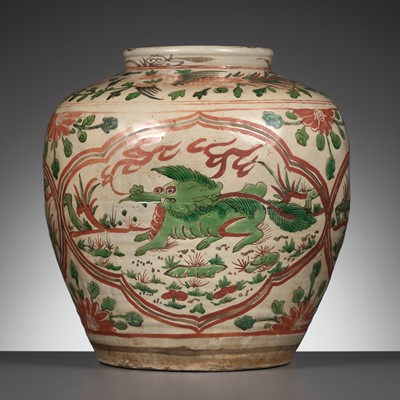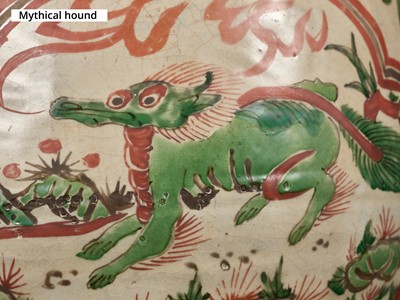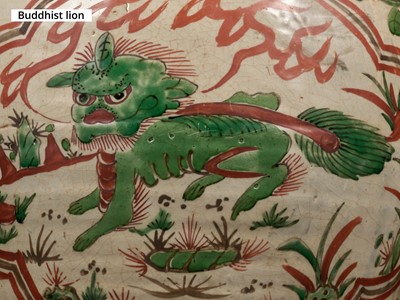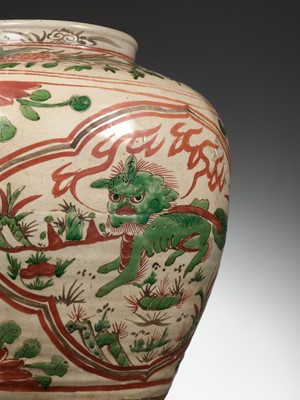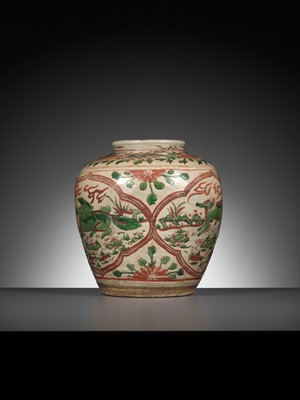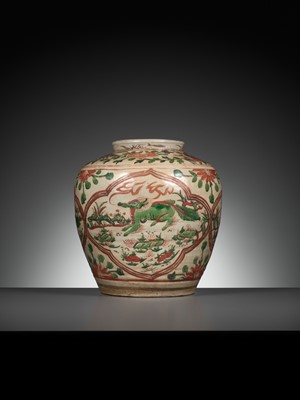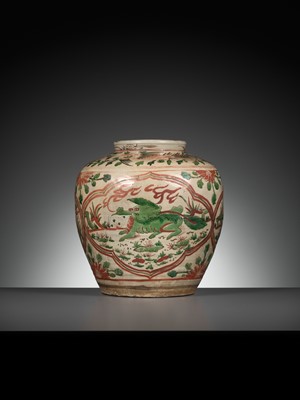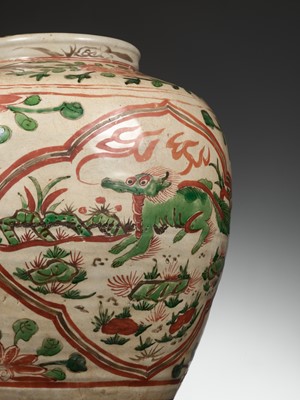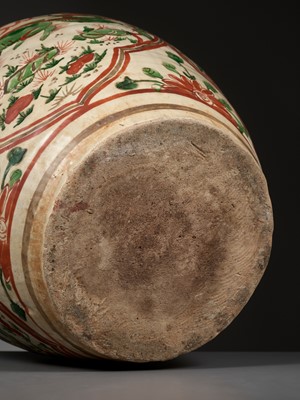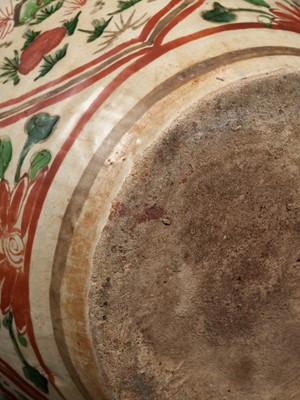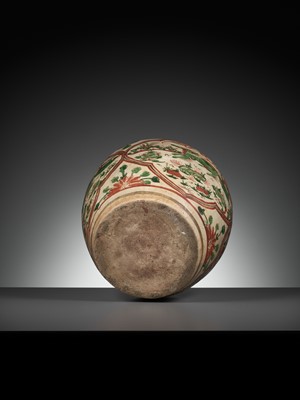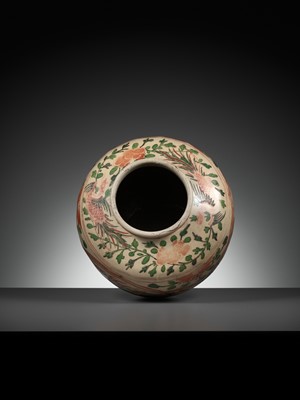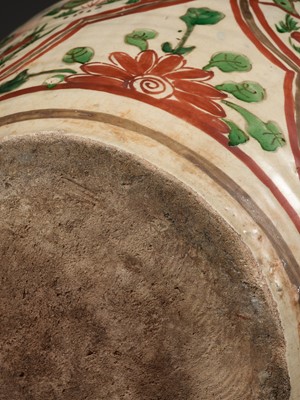11th Oct, 2023 11:00
THREE-DAY AUCTION - Fine Chinese Art / 中國藝術集珍 / Buddhism & Hinduism
85
A LARGE AND RARE ‘QILIN, MYTHICAL HOUND AND BUDDHIST LION’ JAR, MING DYNASTY, JIAJING PERIOD, 1521-1567
嘉靖開光麒麟太獅罐
Sold for €6,800
including Buyer's Premium
Expert’s note: The combination of iron-red and green glazes was utilized primarily during the Jiajing period (1521-1567). According to Daisy Lion-Goldschmidt in Ming Porcelain, New York, 1978, page 164, in her discussion of the 'Red-and-Green' Group, this palette would come to dominate polychrome porcelains, eventually leading to the appearance of famille verte during the second half of the seventeenth century.
China. The ovoid body is supported on a flat base and rises to a short and slightly flared neck with a lipped rim. Boldly painted in green, red, and aubergine enamels with three lobed panels enclosing a mythical hound, a Buddhist lion and a Qilin, each with a long snout and standing foursquare amid foliage and rockwork depicted in profile and facing the viewer, surrounded by floral sprays, all beneath a band of phoenixes and peony blossoms below the rim decorated with lingzhi sprays. Covered overall with a finely crackled transparent glaze of a pale-ivory tone, the interior with a dark brown glaze.
Provenance: The J. M. Hu, Zande Lou Collection. An old, padded silk box fitted to the vase accompanies the lot. Jenmou Hu (1911-1995) was arguably the most important collector of Chinese ceramics in the last century. In both his personal collection and in his bequests to cultural institutions, J. M. Hu stood as a model of the modern scholar-collector. The eldest son of the influential banker Hu Chun, he was raised in an elegant private residence amongst his many stepbrothers and stepsisters. In keeping with tradition, he was given a rigorous background in the Chinese classics, supplemented by a Western-style education. He first encountered Chinese ceramics during his student years, when he purchased a nineteenth-century brush washer for his desk. This initial foray into collecting would become emblematic of J. M. Hu’s poignant relationship with art: even amidst the upheavals of war and the evolution of his collection, the modest brush-washer stayed with him until his death in 1995. Hu’s boyhood studies within the Chinese literati tradition greatly informed his philosophical approach to life and collecting; humble and erudite, he consistently affirmed that it was the visceral connection between a collector and his acquisitions that was of essential importance. True value, in J. M. Hu’s estimation, lay far beyond monetary worth. A noted traditionalist, he went to great lengths designing wooden stands and fitted boxes to preserve and display his Chinese treasures and delighted in sharing the collection with fellow connoisseurs. For J. M. Hu, collecting was a serious, scholarly pursuit not to be taken lightly. The joy of art came with a responsibility to honor both the artist and the object. Hu often spoke of the three necessary criteria in collecting: zhen (authenticity), jing (rarity and quality), and xin (condition). Yet it was an individual’s bond with a work of art, as evidenced in J. M. Hu’s beloved brush washer, that was of fundamental significance. In handling and examining his ceramics, Hu sought that indefinable delight that could come only from the beauty of artistry. In the tradition of Chinese literati who bestowed symbolic monikers upon their studios, libraries, and collections, the name of J. M. Hu’s studio, Zande Lou, referenced the influential Lanting Xu of the famed Jin dynasty calligrapher Wang Xizhi, a text that describes Zande as a person’s inner happiness. Although J. M. Hu intended the meaning of Zande to express this fleeting happiness, which he experienced as a collector when examining an object, the word has also come to be interpreted as the inherently transitory nature of collecting and possessing fine art. J. M. Hu’s collection of Chinese ceramics provided abundant opportunity for personal scholarship and historical investigation. As early as the 1940s, he longed for a welcoming social environment where like-minded collectors could share and discuss art and objects. Two decades later, he established the Min Chiu Society in Hong Kong alongside fellow collectors K.P. Chen and J.S. Lee. A noted cultural philanthropist, J. M. Hu gifted substantial groupings from his collection to the Shanghai Museum in 1950 and again in 1989. Many of these objects remain on view in the museum’s Zande Lou Gallery. To this day, J. M. Hu remains a celebrated figure amongst collectors of Chinese art.
Condition: Remarkably well preserved, commensurate with age. Expected old wear and firing irregularities, including some burst bubbles, firing cracks, tiny bumps, pitting, dark spots, and glaze recesses. Occasional light scratches. Minor chips to base, mostly smoothened over time. Small hairlines. Displaying exceptionally, due to its size and excellent condition.
Weight: 13.5 kg
Dimensions: Height 40 cm
Please click here to read the full description
Literature comparison:
Compare a related red and green enameled porcelain ‘min yao’ dish donated by R. Soame Jenyns, 30.3 cm in diameter, dated to the Ming dynasty, likely Jiajing, in the British Museum, registration number 1951,1010.1. Compare a related polychrome enameled jar decorated with horses, with a Jiajing mark and of the period, 18 cm high, in the Metropolitan Museum of Art, accession number 1991.253.58.
Auction result comparison:
Type: Related
Auction: Christie’s New York, 24 March 2023, lot 1036
Price: USD 32,760 or approx. EUR 30,000 converted at the time of writing
Description: A very rare green and red-enameled ‘fish’ jar, Ming dynasty, 16th century
Expert remark: Compare the related form and decoration. Note the different motif and smaller size (24.8 cm high).
点此阅读中文翻译 (Chinese Translation)
嘉靖開光麒麟太獅罐
中國。罐小口,豐肩,鼓腹,平足。五彩開光描繪一隻神犬、一隻太獅和一隻麒麟,周圍環繞著花卉卷草紋。通體施淺色透明釉,細開片,內施黑褐色釉。
專家注釋:礬紅色和綠色釉的組合主要在嘉靖時期(1521-1567)使用。根據Daisy Lion-Goldschmidt 在《Ming Porcelain》,紐約,1978 年,第164 頁中對“紅綠”組的討論,在彩瓷中舉足輕重,最終於十七世紀下半葉出現明代粉彩。
來源:胡惠春暫得樓收藏。胡惠春(1911-1995),別名胡仁牧,可以說是上個世紀最重要的中國陶瓷收藏家之,是現代學者收藏家的典範。作為有影響力的銀行家胡筆江的長子,他在一所私人住宅中與眾多兄弟和姐妹一起長大。秉承傳統,他接受了嚴謹的中國經典背景,並輔以西式教育。他第一次接觸中國陶瓷是在他的學生時代,當時他為他的辦公桌買了一個十九世紀的筆洗。最初對收藏的嘗試成為胡惠春與藝術聯繫,即使戰爭動盪,他的筆洗一直陪伴著他直到 1995 年去世。傳統極大地影響了他對生活和收藏的哲學態度;他謙遜而博學,始終堅信收藏家與其收藏品之間的內在聯繫至關重要。 在胡惠春看來,藏品真正的價值遠遠超出其金錢價值。他是一位出名的傳統主義者,不遺餘力地設計木架和合適的盒子來保存和展示他的中國收藏,並樂於與其他鑑賞家分享這些收藏。對於胡惠春來說,收藏是一項嚴肅的學術追求,不容輕視。 藝術的樂趣伴隨著尊重藝術家和藏品的責任。胡惠春經常談到收藏的三個必要標準:真(真實性)、精(稀有性和質量)和心(條件)。然而,正如胡惠春鍾愛的筆洗所證明的那樣,個人與藝術品的聯繫具有根本意義。在處理和檢查他的陶瓷時,胡先生追求那種來自藝術之美的無法形容的愉悅。按照中國文人為書房、圖書館和藏品命名的傳統,互惠春為其收藏取名暫得樓,出自《蘭亭序》,指任何珍藏都不可能永遠擁有,足見胡氏心境之豁達。胡惠春的中國陶瓷收藏為個人學術研究和歷史調查提供了豐富的機會。早在二十世紀四十年代,他就渴望有一個溫馨的社交環境,志同道合的收藏家可以在這里分享和討論藝術和物品。二十年後,他與其他收藏家 K.P. 在香港成立了敏求學社。作為著名的文化慈善家,胡惠春於1950至1989年間,共捐了近360件瓷器予上海博物館,這些重要的瓷器藏品至今仍然開放予公眾參觀,為人津津樂道。
品相:保存完好,有磨損和燒製不規則性,包括一些破裂的氣泡、燒製裂痕,以及微小的凸起、麻點、黑點和釉面凹陷。局部輕微劃痕。有冲線。
重量:13.5 公斤
尺寸:高 40 厘米
文獻比較:
比較一件相近的明代嘉靖紅綠閔窯琺瑯盤,直徑30.3 釐米,R. Soame Jenyns捐贈至大英博物館,館藏編號1951,1010.1。比較一件相近的嘉靖款及年代彩釉罐,高18 釐米,收藏於大都會藝術博物館,館藏編號1991.253.58。
拍賣結果比較:
形制:相近
拍賣:紐約佳士得,2023年3月24日,lot 1036
價格:USD 32,760(相當於今日EUR 30,000)
描述:明十六世紀紅綠彩魚藻紋罐
專家評論:比較相近的外形和裝飾。請注意不同的主題和尺寸較小 (24.8 釐米 高)。
Expert’s note: The combination of iron-red and green glazes was utilized primarily during the Jiajing period (1521-1567). According to Daisy Lion-Goldschmidt in Ming Porcelain, New York, 1978, page 164, in her discussion of the 'Red-and-Green' Group, this palette would come to dominate polychrome porcelains, eventually leading to the appearance of famille verte during the second half of the seventeenth century.
China. The ovoid body is supported on a flat base and rises to a short and slightly flared neck with a lipped rim. Boldly painted in green, red, and aubergine enamels with three lobed panels enclosing a mythical hound, a Buddhist lion and a Qilin, each with a long snout and standing foursquare amid foliage and rockwork depicted in profile and facing the viewer, surrounded by floral sprays, all beneath a band of phoenixes and peony blossoms below the rim decorated with lingzhi sprays. Covered overall with a finely crackled transparent glaze of a pale-ivory tone, the interior with a dark brown glaze.
Provenance: The J. M. Hu, Zande Lou Collection. An old, padded silk box fitted to the vase accompanies the lot. Jenmou Hu (1911-1995) was arguably the most important collector of Chinese ceramics in the last century. In both his personal collection and in his bequests to cultural institutions, J. M. Hu stood as a model of the modern scholar-collector. The eldest son of the influential banker Hu Chun, he was raised in an elegant private residence amongst his many stepbrothers and stepsisters. In keeping with tradition, he was given a rigorous background in the Chinese classics, supplemented by a Western-style education. He first encountered Chinese ceramics during his student years, when he purchased a nineteenth-century brush washer for his desk. This initial foray into collecting would become emblematic of J. M. Hu’s poignant relationship with art: even amidst the upheavals of war and the evolution of his collection, the modest brush-washer stayed with him until his death in 1995. Hu’s boyhood studies within the Chinese literati tradition greatly informed his philosophical approach to life and collecting; humble and erudite, he consistently affirmed that it was the visceral connection between a collector and his acquisitions that was of essential importance. True value, in J. M. Hu’s estimation, lay far beyond monetary worth. A noted traditionalist, he went to great lengths designing wooden stands and fitted boxes to preserve and display his Chinese treasures and delighted in sharing the collection with fellow connoisseurs. For J. M. Hu, collecting was a serious, scholarly pursuit not to be taken lightly. The joy of art came with a responsibility to honor both the artist and the object. Hu often spoke of the three necessary criteria in collecting: zhen (authenticity), jing (rarity and quality), and xin (condition). Yet it was an individual’s bond with a work of art, as evidenced in J. M. Hu’s beloved brush washer, that was of fundamental significance. In handling and examining his ceramics, Hu sought that indefinable delight that could come only from the beauty of artistry. In the tradition of Chinese literati who bestowed symbolic monikers upon their studios, libraries, and collections, the name of J. M. Hu’s studio, Zande Lou, referenced the influential Lanting Xu of the famed Jin dynasty calligrapher Wang Xizhi, a text that describes Zande as a person’s inner happiness. Although J. M. Hu intended the meaning of Zande to express this fleeting happiness, which he experienced as a collector when examining an object, the word has also come to be interpreted as the inherently transitory nature of collecting and possessing fine art. J. M. Hu’s collection of Chinese ceramics provided abundant opportunity for personal scholarship and historical investigation. As early as the 1940s, he longed for a welcoming social environment where like-minded collectors could share and discuss art and objects. Two decades later, he established the Min Chiu Society in Hong Kong alongside fellow collectors K.P. Chen and J.S. Lee. A noted cultural philanthropist, J. M. Hu gifted substantial groupings from his collection to the Shanghai Museum in 1950 and again in 1989. Many of these objects remain on view in the museum’s Zande Lou Gallery. To this day, J. M. Hu remains a celebrated figure amongst collectors of Chinese art.
Condition: Remarkably well preserved, commensurate with age. Expected old wear and firing irregularities, including some burst bubbles, firing cracks, tiny bumps, pitting, dark spots, and glaze recesses. Occasional light scratches. Minor chips to base, mostly smoothened over time. Small hairlines. Displaying exceptionally, due to its size and excellent condition.
Weight: 13.5 kg
Dimensions: Height 40 cm
Please click here to read the full description
Literature comparison:
Compare a related red and green enameled porcelain ‘min yao’ dish donated by R. Soame Jenyns, 30.3 cm in diameter, dated to the Ming dynasty, likely Jiajing, in the British Museum, registration number 1951,1010.1. Compare a related polychrome enameled jar decorated with horses, with a Jiajing mark and of the period, 18 cm high, in the Metropolitan Museum of Art, accession number 1991.253.58.
Auction result comparison:
Type: Related
Auction: Christie’s New York, 24 March 2023, lot 1036
Price: USD 32,760 or approx. EUR 30,000 converted at the time of writing
Description: A very rare green and red-enameled ‘fish’ jar, Ming dynasty, 16th century
Expert remark: Compare the related form and decoration. Note the different motif and smaller size (24.8 cm high).
点此阅读中文翻译 (Chinese Translation)
嘉靖開光麒麟太獅罐
中國。罐小口,豐肩,鼓腹,平足。五彩開光描繪一隻神犬、一隻太獅和一隻麒麟,周圍環繞著花卉卷草紋。通體施淺色透明釉,細開片,內施黑褐色釉。
專家注釋:礬紅色和綠色釉的組合主要在嘉靖時期(1521-1567)使用。根據Daisy Lion-Goldschmidt 在《Ming Porcelain》,紐約,1978 年,第164 頁中對“紅綠”組的討論,在彩瓷中舉足輕重,最終於十七世紀下半葉出現明代粉彩。
來源:胡惠春暫得樓收藏。胡惠春(1911-1995),別名胡仁牧,可以說是上個世紀最重要的中國陶瓷收藏家之,是現代學者收藏家的典範。作為有影響力的銀行家胡筆江的長子,他在一所私人住宅中與眾多兄弟和姐妹一起長大。秉承傳統,他接受了嚴謹的中國經典背景,並輔以西式教育。他第一次接觸中國陶瓷是在他的學生時代,當時他為他的辦公桌買了一個十九世紀的筆洗。最初對收藏的嘗試成為胡惠春與藝術聯繫,即使戰爭動盪,他的筆洗一直陪伴著他直到 1995 年去世。傳統極大地影響了他對生活和收藏的哲學態度;他謙遜而博學,始終堅信收藏家與其收藏品之間的內在聯繫至關重要。 在胡惠春看來,藏品真正的價值遠遠超出其金錢價值。他是一位出名的傳統主義者,不遺餘力地設計木架和合適的盒子來保存和展示他的中國收藏,並樂於與其他鑑賞家分享這些收藏。對於胡惠春來說,收藏是一項嚴肅的學術追求,不容輕視。 藝術的樂趣伴隨著尊重藝術家和藏品的責任。胡惠春經常談到收藏的三個必要標準:真(真實性)、精(稀有性和質量)和心(條件)。然而,正如胡惠春鍾愛的筆洗所證明的那樣,個人與藝術品的聯繫具有根本意義。在處理和檢查他的陶瓷時,胡先生追求那種來自藝術之美的無法形容的愉悅。按照中國文人為書房、圖書館和藏品命名的傳統,互惠春為其收藏取名暫得樓,出自《蘭亭序》,指任何珍藏都不可能永遠擁有,足見胡氏心境之豁達。胡惠春的中國陶瓷收藏為個人學術研究和歷史調查提供了豐富的機會。早在二十世紀四十年代,他就渴望有一個溫馨的社交環境,志同道合的收藏家可以在這里分享和討論藝術和物品。二十年後,他與其他收藏家 K.P. 在香港成立了敏求學社。作為著名的文化慈善家,胡惠春於1950至1989年間,共捐了近360件瓷器予上海博物館,這些重要的瓷器藏品至今仍然開放予公眾參觀,為人津津樂道。
品相:保存完好,有磨損和燒製不規則性,包括一些破裂的氣泡、燒製裂痕,以及微小的凸起、麻點、黑點和釉面凹陷。局部輕微劃痕。有冲線。
重量:13.5 公斤
尺寸:高 40 厘米
文獻比較:
比較一件相近的明代嘉靖紅綠閔窯琺瑯盤,直徑30.3 釐米,R. Soame Jenyns捐贈至大英博物館,館藏編號1951,1010.1。比較一件相近的嘉靖款及年代彩釉罐,高18 釐米,收藏於大都會藝術博物館,館藏編號1991.253.58。
拍賣結果比較:
形制:相近
拍賣:紐約佳士得,2023年3月24日,lot 1036
價格:USD 32,760(相當於今日EUR 30,000)
描述:明十六世紀紅綠彩魚藻紋罐
專家評論:比較相近的外形和裝飾。請注意不同的主題和尺寸較小 (24.8 釐米 高)。
Zacke Live Online Bidding
Our online bidding platform makes it easier than ever to bid in our auctions! When you bid through our website, you can take advantage of our premium buyer's terms without incurring any additional online bidding surcharges.
To bid live online, you'll need to create an online account. Once your account is created and your identity is verified, you can register to bid in an auction up to 12 hours before the auction begins.
Intended Spend and Bid Limits
When you register to bid in an online auction, you will need to share your intended maximum spending budget for the auction. We will then review your intended spend and set a bid limit for you. Once you have pre-registered for a live online auction, you can see your intended spend and bid limit by going to 'Account Settings' and clicking on 'Live Bidding Registrations'.
Your bid limit will be the maximum amount you can bid during the auction. Your bid limit is for the hammer price and is not affected by the buyer’s premium and VAT. For example, if you have a bid limit of €1,000 and place two winning bids for €300 and €200, then you will only be able to bid €500 for the rest of the auction. If you try to place a bid that is higher than €500, you will not be able to do so.
Online Absentee and Telephone Bids
You can now leave absentee and telephone bids on our website!
Absentee Bidding
Once you've created an account and your identity is verified, you can leave your absentee bid directly on the lot page. We will contact you when your bids have been confirmed.
Telephone Bidding
Once you've created an account and your identity is verified, you can leave telephone bids online. We will contact you when your bids have been confirmed.
Classic Absentee and Telephone Bidding Form
You can still submit absentee and telephone bids by email or fax if you prefer. Simply fill out the Absentee Bidding/Telephone bidding form and return it to us by email at office@zacke.at or by fax at +43 (1) 532 04 52 20. You can download the PDF from our Upcoming Auctions page.
How-To Guides
How to Create Your Personal Zacke Account
How to Register to Bid on Zacke Live
How to Leave Absentee Bids Online
How to Leave Telephone Bids Online
中文版本的操作指南
创建新账号
注册Zacke Live在线直播竞拍(免平台费)
缺席投标和电话投标
Third-Party Bidding
We partner with best-in-class third-party partners to make it easy for you to bid online in the channel of your choice. Please note that if you bid with one of our third-party online partners, then there will be a live bidding surcharge on top of your final purchase price. You can find all of our fees here. Here's a full list of our third-party partners:
- 51 Bid Live
- EpaiLive
- ArtFoxLive
- Invaluable
- LiveAuctioneers
- the-saleroom
- lot-tissimo
- Drouot
Please note that we place different auctions on different platforms. For example, in general, we only place Chinese art auctions on 51 Bid Live.
Bidding in Person
You must register to bid in person and will be assigned a paddle at the auction. Please contact us at office@zacke.at or +43 (1) 532 04 52 for the latest local health and safety guidelines.
